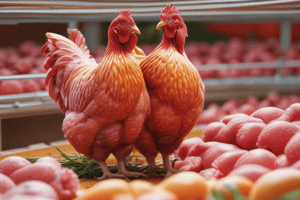Podcast
Questions and Answers
Which method is most effective for ensuring poultry is cooked thoroughly?
Which method is most effective for ensuring poultry is cooked thoroughly?
- Using a thermometer to check internal temperature (correct)
- Cooking until the meat is no longer pink
- Boiling the poultry in water
- Cooking at a high temperature for a short time
What is the recommended minimum internal temperature for cooked poultry?
What is the recommended minimum internal temperature for cooked poultry?
- 200°F
- 165°F (correct)
- 145°F
- 180°F
What equipment is essential for safely handling poultry in the kitchen?
What equipment is essential for safely handling poultry in the kitchen?
- A meat mallet
- Separate cutting boards for raw and cooked foods (correct)
- A wooden chopping board
- A pair of scissors
Which of the following is NOT a safe practice when preparing poultry dishes?
Which of the following is NOT a safe practice when preparing poultry dishes?
What is the best way to store raw poultry to ensure freshness?
What is the best way to store raw poultry to ensure freshness?
Poultry should be cooked to a minimum internal temperature of at least ______ degrees Fahrenheit.
Poultry should be cooked to a minimum internal temperature of at least ______ degrees Fahrenheit.
Proper ______ is essential to avoid contamination when preparing poultry dishes.
Proper ______ is essential to avoid contamination when preparing poultry dishes.
Always wash your hands with soap and water after handling ______.
Always wash your hands with soap and water after handling ______.
Use a separate ______ board for raw poultry to prevent cross-contamination with other foods.
Use a separate ______ board for raw poultry to prevent cross-contamination with other foods.
To ensure the safety of poultry dishes, always marinate the meat in the ______ instead of at room temperature.
To ensure the safety of poultry dishes, always marinate the meat in the ______ instead of at room temperature.
Flashcards
Poultry Dishes
Poultry Dishes
Dishes made from poultry, such as chicken, turkey, and duck.
Game Dishes
Game Dishes
Food dishes made from wild animals like venison or rabbit.
Preparing Dishes
Preparing Dishes
The process of making food, from ingredients to serving.
Poultry
Poultry
Signup and view all the flashcards
Game
Game
Signup and view all the flashcards
Preparing Poultry
Preparing Poultry
Signup and view all the flashcards
Preparing Game
Preparing Game
Signup and view all the flashcards
Study Notes
Poultry and Game Dishes
- Poultry refers to domesticated birds raised for eggs and meat.
- Chickens are the most popular poultry for meat and egg production.
- Ducks are waterfowl, popular in Asian cuisine.
- Geese are related to ducks, and are eaten in some cultures.
- Turkeys are domesticated varieties of American wild birds, popular in Australia.
- Game birds are wild birds hunted for food.
Market Forms of Poultry
- Whole chicken: Marketed fresh or frozen, considered a budget-friendly option.
- Cuts: Whole chicken cut into different parts (e.g., wing tip, breast fillet, thigh, drumstick).
- Roast chicken: Whole chicken cooked using dry heat (oven or open fire).
- Ready-to-cook: Poultry parts separately packaged for convenience.
Different Cuts of Poultry
- Whole chicken: The entire bird, excluding the head and giblets.
- Halves: Chicken split from front to back, through the backbone and keel, producing two halves of roughly equal weight.
- Breast: Popular cut with high protein and low fat content.
- Drumstick: The portion between the knee joint and hock.
- Legs: Combining the drumstick and thigh.
- Tenders: Meat beneath the breast, ideal for strips or fillets.
- Thigh: Located above the knee joint, renowned for taste.
- Whole wings: Include drumette, wing-mid section, and tip.
- 8-Piece cut: Whole bird divided into two breasts, two wings, two thighs, and two drumsticks.
- Wing-mid section: The portion between the elbow and tip, sometimes known as the wing flat or mid-joint.
Guidelines for Purchasing Poultry
Live Chicken
- Select alert, healthy, well-feathered, and well-formed birds.
- Eyes should be bright and alert.
- The chicken's body should be free of injuries and skin damage.
- A good layer of fat is desired and free of tears, broken bones, bruises, and blisters.
- Younger chickens are generally more tender.
Live Chicken (Continued)
- Breastbone tip should be flexible.
- Chicken should have a plump, well-rounded body.
- Skin should be clean, smooth, and pliable.
Dressed Chicken
- Look for birds with intact heads, feet, and viscera.
- The bird should be clean and well-fleshed, with moderate fat covering.
- Ensure absence of pin feathers, cuts, or tears.
- Avoid chickens with missing parts, broken bones, or discoloration.
Ready-to-cook
- Chicken should be cleaned and eviscerated with feet and head removed.
- Available chilled or frozen.
- Ensure chilled poultry is stored in the refrigerator for no more than three days.
Studying That Suits You
Use AI to generate personalized quizzes and flashcards to suit your learning preferences.




